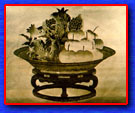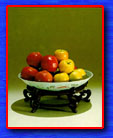During the Ching Dynasty, ordinary people often arranged majestic intellectual
compositions on holidays and other festive occasions as a symbol of celebration
and rejoicing. The delicate workmanship of the basket in this composition
is complemented by its lovely surface design. Flowers include those most
commonly seen during the final month of the lunar year, the so-called "three
friends of winter": the plum blossom, the camellia, and the narcissus.
In this triumvirate the camellia serves as the host, providing an element
of stability: the narcissus as the guest, lending its lush, vivid color
to the arrangement: and the plum blossom its extended branches as retainer,
adding balance and elaboration. Branches and leaves thrust upward in a
setting of prosperity and well-being.²
![]()


Strikingly lovely effects were often achieved in flower arrangements through a shimmering interplay of hue and color created by the glossy surfaces of fruits and vegetables. Although the fruit and the vessel containing it are evenly proportioned in this composition, when viewed from above the former appears to dominate the latter by a margin of three to two, producing a sensation of depth and solidity. The pomegranate and cherry-apple are joined in a ratio of eight to five, generating a variegated motley of pastel reds and whites, in a simple yet powerful contrast suggestive of more modern techniques.
![]()
[preface] [
styles] [religious] [palace]
[literati] [folk]
[9 pricniples] [significance]
[preveration] [vessels]
[appreciatin]
[Pavilion of Taiwan,
R.O.c] [Cultures]
[Council For Cultural
Affairs]